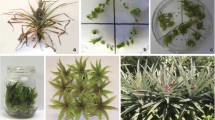Abstract
Patchouli (Pogostemon cablin) was found infected with a viral disease showing mosaic symptoms on the leaves in the Chand-pur farm at Institute of Himalayan Bioresource Technology campus, Palampur, Himachal Pradesh, India. After ELISA, RT-PCR, IC-PCR and sequencing, the virus was identified as Peanut stripe virus (PStV). Sequence comparison with corresponding sequences of established potyviruses showed 52–93% homol-ogy at nucleotide level. Peanut stripe virus was eliminated from Patchouli plants using meristem tip culture. MS medium amended with benzylaminopurine (2 mg l−1) and indole3-bu-tyric acid (0.05 mg l−1) was used for shoot proliferation and rooting of plants, respectively. More than 88.89% virus-free plants were obtained from 0.2 mm of meristem as shown by indirect ELISA whereas 80.55% virus-free plants were obtained from 0.3 mm size of meristem as indicated by RT-PCR.
Zusammenfassung
Auf der Chandpur Farm des Institute of Himalayan Bioresour-ce Technology, Campus Palampur, Himachal Pradesh, Indien, wurde eine Virose mit Blattmosaik-Symptomen an Indischem Patschuli (Pogostemon cablin) entdeckt. Mittels ELISA, RT-PCR, IC-PCR und Gensequenzierung wurde der Erreger als Peanut stripe virus (PStV) identifiziert. Ein Sequenzvergleich mit bekannten Potyviren ergab Homologien von 52–93% auf dem Nucleotidlevel. Das Peanut stripe virus konnte mit Hilfe der Meristemspitzenkultur aus den Patschulipflanzen elimi-niert werden. Zur Spro ß - und Wurzelbildung der Calli wurde MS-Medium verwendet, dem 2 mg ml−1 Benzylaminopurin bzw. 0,05 mg ml−1 Indolbuttersäure zugegeben wurde. Mehr als 88,89% virusfreie Pflanzen wurden, wie die indirekte ELISA zeigte, aus 0,2 mm gro ß en Meristemstücken gewon-nen, während die RT-PCR ergab, dass sich aus 0,3 mm gro ß en Meristemen 80,55% virusfreie Pflanzen entwickelten.
Similar content being viewed by others
References
Anonymous, 1977: Isolation and structural analysis of pogos-tone, an antifungal component from the Chinese drug Dwang Ho Hsiang (Pogostemon cablin (Blanco) Benth). Ko Hsueeh Pao 22, 318.
Brants, D.H., H. Vermeulen, 1965: Production of virus free freesias by means of meristem culture. Eur. J. Plant Pathol. 71, 25–27.
Chenna, R., H. Sugawara, T. Koike, R. Lopez, T.J. Gibson, D.G. Higgins, J.D. THOMPSON, 2003: Multiple sequence alignment with the Clustal series of programs. Nucleic Acids Res. 31, 3497–3500.
Clark, M.F., A.N. Adams, 1977: Characterization of micro plate method of enzyme linked immunosorbent assay for detection of plant viruses. J. Gen. Virol. 34, 478–483.
Corpet, F., 1988: Multiple sequence alignment with hierarchical clustering. Nucleic Acids Res. 16, 10881–10890.
Gomez, K.A., A.A. Gomez, 1984: Statistical Procedure for Agricultural Research. 2nd edition. John Wiley and Sons, Singapore.
Jain, R.K., I. Lahiri, A. Varma, 2000: Peanut stripe potyvirus: prevalence, detection and serological relationship. Indian Phytopathol. 53, 14–18.
Kukreja, A.K., A.K. Mathur, M. Zaim, 1990: Mass production of virus-free patchouli plants [Pogostemon cablin (Blanco) Benth.] by vitro culture. Trop. Agric. 67, 101–104.
Mckern, N.M., D.D. Shukla, O.W. Barnett, H.J. Vetten, J. Dijkstra, L.A. Whittaker, C.W. Ward, 1992: Coat protein properties suggest that Azuki bean mosaic virus, Blackeye cowpea mosaic virus, Peanut stripe virus and three strains from soybean are all strains of the same potyvirus. Intervi-rology 33, 121–134
Murashige, T., F.F. Skoog, 1962: Revised medium for rapid growth and bioassay with tobacco tissue cultures. Physiol. Plant. 15, 473–497.
Page, R.D.M., 1996: TreevIEW–An application to display phylogenetic trees on personal computers. Comp. Appl. Biosci. 12, 357–358.
Rao, R.D., V.J. Chakrabarty, A.S. Reddy, 1989: Peanut stripe virus occurrence in India. Indian Phytopathol. 42, 487–491.
Saiz, M., J. Dopazo, S. Castro, J. Romero, 1994: Evolutionary relationships among BCMV strains and closely related potyviruses. Virus Res. 31, 39–48.
Sanger, F., S. Nickelen, A.R. Coulson, 1977: DnA sequencing with chain termination inhibitors. Proc. Natl. Acad. Sci. USA 74, 5463–5467.
Sharma, R., 2002: Medicinal Plants of India- an Encylopaedia, pp. 197–198. Daya Publishing House, New Delhi.
Sugimura, Y., M.S. Padayhag, K.N. Ceniza, S. Eguchi, T. Natsuaki, S. Okuda, 1995: Essential oil production increased by using virus free patchouli plants derived from meristem-tip culture. Plant Pathol. 44, 510–515.
Tatusova, A. T., T.L. Maiden, 1999: Blast 2 sequences. A new tool for comparing protein and nucleotide sequences. FEMS Microbiol. Lett. 174, 247–250.
Van der Vlugt, R.A.A., P. Steffens, C. Cuperus, E. Barg, D.E. Lesemann, L. Bos, H.J. Vetten, 1999: Further evidence that Shallot yellow stripe virus (SYSV) is a distinct potyvirus and reidentification of Welsh onion stripe virus as a Sysv strain. Phytopathology 89, 148–155.
Vetten, H.J., D.E. Lesemann, E. Maiss, 1992: Serotype A and B strains of BCMV are two distinct potyviruses. In: O.W. Barnett (ed.): Potyvirus Taxonomy, pp. 415–431. Springer, Wien, NewYork.
Xu, Z., Z. Yu, J. Lui, O.W. Barnett, 1983: Virus causing peanut mild mottle in Hubei province, China Plant Dis. 67, 1029–1032.
Author information
Authors and Affiliations
Rights and permissions
About this article
Cite this article
Singh, M.K., Chandel, V., Hallan, V. et al. Occurrence of Peanut stripe virus on patchouli and raising of virus-free patchouli plants by meristem tip culture. J Plant Dis Prot 116, 2–6 (2009). https://doi.org/10.1007/BF03356278
Received:
Accepted:
Published:
Issue Date:
DOI: https://doi.org/10.1007/BF03356278




